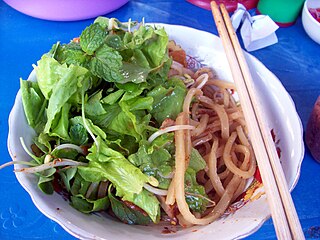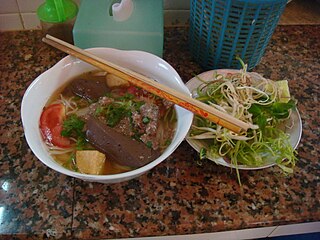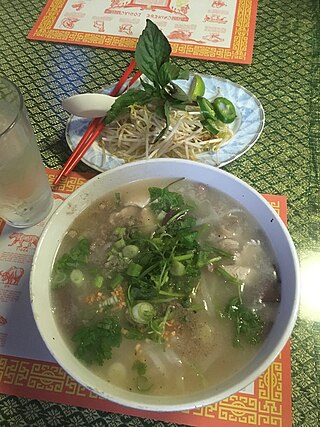
Hokkien mee, literally "Fujian noodles", is a series of related Southeast Asian dishes that have their origins in the cuisine of China's Fujian (Hokkien) province.

Kuyteav is a Cambodian noodle soup consisting of rice noodles with pork stock and toppings. Originating from Chinese Cambodian cuisine, it is now a popular breakfast dish across all of Cambodia. The kuyteav can be found at marketplace stalls, roadside vendors, restaurants and in shophouses across the country, and is distinguished by its clear broth and array of herbs, aromatics and other garnishes and condiments. A related dish is the Vietnamese Hủ tiếu, which was introduced to Vietnam by Chinese Cambodian immigrants in the 1970s.

Pancit, also spelled pansít, is a general term referring to various traditional noodle dishes in Filipino cuisine. There are numerous types of pancit, often named based on the noodles used, method of cooking, place of origin, equal and constant diameter or the ingredients. Most pancit dishes are characteristically served with calamansi, which adds a citrusy flavor profile.

Banmian or pan mee is a popular Chinese noodle dish, consisting of handmade noodles served in soup. Other types of handmade noodles include youmian, or mee hoon kueh.

Penang cuisine is the cuisine of the multicultural society of Penang, Malaysia. Most of these cuisine are sold at road-side stalls, known as "hawker food" and colloquially as "muckan carts". Local Penangites typically find these hawker fares cheaper and easier to eat out at due to the ubiquitousness of the hawker stalls and that they are open for much of the day and night. Penang island. On February 22, 2013, Penang was ranked by CNN Travel as one of the top ten street food cities in Asia. Penang has also been voted by Lonely Planet as the top culinary destination in 2014.

Noodle soup refers to a variety of soups with noodles and other ingredients served in a light broth. Noodle soup is a common dish across East Asia, Southeast Asia and the Himalayan states of South Asia. Various types of noodles are used, such as rice noodles, wheat noodles and egg noodles.

Chinese Indonesian cuisine is characterized by the mixture of Chinese with local Indonesian style. Chinese Indonesians, mostly descendant of Han ethnic Hokkien and Hakka speakers, brought their legacy of Chinese cuisine, and modified some of the dishes with the addition of Indonesian ingredients, such as kecap manis, palm sugar, peanut sauce, chili, santan and local spices to form a hybrid Chinese-Indonesian cuisine. Some of the dishes and cakes share the same style as in Malaysia and Singapore, known as Nyonya cuisine by the Peranakan.

Rice vermicelli is a thin form of noodle. It is sometimes referred to as "rice noodles" or "rice sticks", but should not be confused with cellophane noodles, a different Asian type of vermicelli made from mung bean starch or rice starch rather than rice grains themselves.

Mee pok is a Chinese noodle characterized by its flat and yellow appearance, varying in thickness and width. The dish is of Chaoshan origin and is commonly served in the Chaoshan region of China and countries with a significant Chaoshan Chinese immigrant population such as Singapore, Malaysia and Thailand. Mee pok is commonly served tossed in a sauce, though sometimes served in a soup. Meat and vegetables are added on top.

Cao lầu is a regional Vietnamese noodle dish, from the city of Hội An, in central Vietnam's Quảng Nam Province. It typically consists of pork and greens on a bed of rice noodles made from rice which has been soaked in lye water, giving them a characteristic texture and colour that sets the dish apart from other Vietnamese noodle dishes, including others from the same region, such as mì Quảng.

Bánh cuốn is a Vietnamese dish originating from Northern Vietnam.

Bún riêu is a traditional Vietnamese soup of clear stock and rice vermicelli. There are several varieties of bún riêu, including bún riêu cua, bún riêu cá and bún riêu ốc.

Khao piak sen is a rice noodle soup that is a part of traditional Lao cuisine. It is a common comfort food that's great for a cold day. It is the "chicken noodle soup" of Laotian cuisine and does not require too many ingredients, but makes a perfect dish with its simplicity. It is often made in large batches to eat with a large group of people. It is sometimes prepared using pork belly. Chopsticks are commonly used to consume the soup, and it is commonly eaten as a breakfast dish. Khao piak sen is also similar to the Vietnamese noodle soup known as bánh canh. Both khao piak sen and bánh canh noodles are thick and chewy like udon noodles.

Salads that are internationally known as Thai salads with a few exceptions fall into four main preparation methods. In Thai cuisine these are called yam, tam, lap and phla. A few other dishes can also be regarded as being a salad.

Hot and sour soup is a popular example of Sichuan cuisine. Similar versions are found in Henan province, near Beijing, and in Henan cuisine itself, where it may also be known as hulatang or "pepper hot soup" (胡辣汤). Also popular in Southeast Asia, India, Pakistan and the United States, it is a flexible soup which allows ingredients to be substituted or added depending on availability. For example, the American-Chinese version can be thicker as it commonly includes corn starch, whilst in Japan, sake is often added.

Spring rolls are rolled appetizers or dim sum commonly found in Chinese and Southeast Asian cuisines. The kind of wrapper, fillings, and cooking technique used, as well as the name, vary considerably depending on the region's culture, though they are generally filled with vegetables.

Hot pot or hotpot, also known as steamboat, is a dish whereby a heat source placed on the dining table keeps a pot of soup stock simmering, and a variety of Chinese foodstuffs and ingredients are served beside the pot for the diners to put into the hot stock.

Wonton noodles is a noodle dish of Cantonese origin. Wonton noodles were given their name, húntún, in the Tang Dynasty. The dish is popular in Southern China, Hong Kong, Indonesia, Malaysia, Singapore and Thailand. The dish usually consists of egg noodles served in a hot broth, garnished with leafy vegetables and wonton dumplings. The types of leafy vegetables used are usually gai-lan, also known as Chinese broccoli or Chinese kale. Another type of dumpling known as shui jiao (水餃) is sometimes served in place of wonton. Shrimp wonton are mostly known as Hong Kong dumplings. The wontons contain prawns, chicken or pork, and spring onions, with some chefs adding mushroom and black fungus. In Indonesia especially in North Sumatra, West Kalimantan and South Sulawesi, wonton noodles are called mie pangsit.

Indonesian noodles are a significant aspect of Indonesian cuisine which is itself very diverse. Indonesian cuisine recognizes many types of noodles, with each region of the country often developing its own distinct recipes.




















